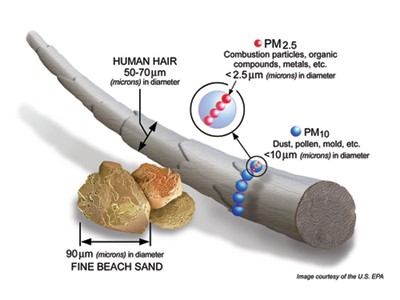![Smoke and glowing embers dominate the forest as wildland firefighters battle the last of the flames of the Harding Fire in north east Saskatchewan by Joanne Francis [Full Landscape]](https://images.ctfassets.net/4f1b2uz8g1t3/5DiZPr98ScMJ3lj4hk7rXo/4730c60b6a764a1ee688f8f9271ba366/Smoke_and_glowing_embers_dominate_the_forest_as_wildland_firefighters_battle_the_last_of_the_flames_of_the_Harding_Fire_in_n.jpg?w=1504&h=300&fl=progressive&q=85&fm=jpg&bg=transparent)
The Health Risks of Wildfire Smoke
Wildfire season isn't going away anytime soon
More frequent and widespread wildfires may become our new normal as climate change progresses. Wildfires are unpredictable and smoke can travel for miles, affecting communities far from the source. The lingering wildfire smoke carries with it serious health risks. This article examines the makeup of this smoke, its short-term and possible long-term effects on health, and provides actionable steps you can take to protect yourself and your family.
What’s in wildfire smoke and why is it so dangerous?
Wildfire smoke is a complex mixture of particulate matter, gasses, vapors, the by-products of burning plastics and heavy metals. The main component of wildfire smoke is fine particulate matter—particles less than 2.5 microns (PM2.5) in diameter. Much smaller than the diameter of human hair and fine beach sand, it is also the most hazardous to human health. About 40% of fine particulate matter released into the atmosphere in the United States. comes from wildfire smoke.
Because fine particulate matter is so small, it can enter deep into the lungs and irritate our respiratory system. The particles can then get into the bloodstream and travel to other organs where they can cause damage.

What are the health effects of wildfire smoke inhalation?
When PM2.5 gets into your lungs, your body's immune system kicks into high gear, similar to its response when fighting viruses or bacteria.
But the body’s defense system cannot eliminate these tiny particles so the immune system works overtime. That can cause systemic inflammation, which can lead to chronic conditions, such as heart disease.
Inhaling high concentrations of smoke and other air pollution can increase the risk of developing lung and heart conditions and can exacerbate asthma, according to the Environmental Protection Agency. PM2.5 can also exacerbate pre-existing lung and heart conditions and even trigger heart attacks. It’s also been shown to cause a decline in cognitive function.
Infants are of particular concern because their lungs are extremely sensitive and still growing. Disrupting that growth with damage from wildfire smoke could translate to lung issues throughout their lives.
What we know about the long-term health effects of wildfire smoke exposure
We know that wildfire smoke can increase respiratory conditions such as asthma and that it can have longer term implications for heart and lung health. However, there's much more to learn about its long-term effects.
This is an important area of research. More of us will be exposed to smoke in the future as wildfires increase in intensity and size. Researchers continue to learn about the long-term impacts smoke exposure has on the body, but what we already know is concerning.
Lung damage and immune system damage demonstrated in animal research
Following the 2008 wildfire in Northern California, scientists at the California National Primate Research Center studied its effect on monkeys. Baby monkeys' lungs were more stiff and rigid than those of monkeys born the following year.
More than 10 years later, the monkeys born in smoke still have abnormally small, stiff lungs. Moreover, the monkeys exposed to wildfire smoke and their offspring had weakened immune responses. Although we cannot directly apply these findings to humans, they may serve as a warning for health outcomes in vulnerable populations.
Some studies link higher rates of cancer with exposure to wildfire smoke. A 2022 study in The Lancet looked at population data in Canada over 20 years and found that long-term exposure to wildfire smoke could increase the risk of lung cancer and brain tumors. The study's authors cautioned that these results need further investigation.

Wildfire smoke is unsafe for anyone, especially when the Air Quality Index (AQI) is in the red (unhealthy) and maroon (hazardous) zones. Some populations are even vulnerable to wildfire smoke inhalation when particulate matter or ground level ozone is at lower levels.
The health risks from wildfire smoke varies by person and age
Some people are at higher risk and can experience more severe effects. The Air Quality Index (AQI) uses the term “sensitive groups” for these populations.
The health effects caused by wildfire smoke also changes over the course of a lifetime. It is greater during childhood because children's lungs are still developing. The risk decreases during young adulthood, but rises again during middle age and older adults.
Additionally, the likelihood of developing heart and lung disease, high blood pressure, and diabetes also increases in these age groups. These individuals need to take extra precautions to minimize their exposure to wildfire smoke.
During wildfire smoke events, everyone should routinely check the Air Quality Index. It’s even more important for vulnerable groups to monitor the AQI daily and follow its activity recommendations.